The Influence of Particle Size and Hydrate Formation Path on the Geomechanical Behavior of Hydrate Bearing Sands
Abstract
:1. Introduction
2. Materials and Methods
2.1. Experimental Set Up
2.2. Soil Selection
2.3. Specimen Preparation
2.4. Hydrate Formation
2.5. Test Methods
2.5.1. RC Testing
2.5.2. Compressional Shear Tests
3. Results
3.1. Hydrate Formation
Influence of Particle Size on Formation Rates
3.2. RC Testing
3.2.1. Evolution of Gmax with Hydrate Formation
3.2.2. Influence of Particle Size Distribution on Evolution of Gmax
3.2.3. Influence of Hydrate Formation Approach on Evolution of Gmax
3.3. Triaxial Compression Tests
Influence of Particle Size Distribution and Formation Method on Stress-Strain Response of Hydrate-Bearing Sands
4. Discussion
4.1. Influence of Hydrate Formation on Stiffness Evolution
4.2. Influence of Particle Size and Formation Method on Small-Strain Stiffness Behavior
4.3. Influence of Particle Size and Hydrate Distribution on the Stress-Strain Response of Different Sands
5. Conclusions
Author Contributions
Funding
Data Availability Statement
Acknowledgments
Conflicts of Interest
References
- Kvenvolden, K.A. Methane hydrates and global climate. Glob. Biogeochem. Cycles 1988, 2, 221–229. [Google Scholar] [CrossRef] [Green Version]
- Milkov, A.V. Global estimates of hydrate-bound gas in marine sediments: How much is really out there? Earth Sci. Rev. 2004, 66, 183–197. [Google Scholar] [CrossRef]
- Boswell, R. Is Gas Hydrate Energy Within reach? Science 2009, 325, 957–958. [Google Scholar] [CrossRef] [PubMed]
- Boswell, R.; Collett, T.S. Current perspectives on gas hydrate resources. Energy Environ. Sci. 2011, 4, 1206–1215. [Google Scholar] [CrossRef]
- Wallmann, K.E.; Pinero, E.; Burwicz, E.; Haeckel, M.; Hensen, C.; Dale, A.; Ruepke, L. The global inventory of methane hydrate in marine sediments: A theoretical approach. Energies 2012, 5, 2449–2498. [Google Scholar] [CrossRef] [Green Version]
- Moridis, G.J.; Sloan, E.D. Gas production potential of disperse low-saturation hydrate accumulations in oceanic sediments. Energy Convers. Manag. 2007, 48, 1834–1849. [Google Scholar] [CrossRef] [Green Version]
- Torres, M.; Tréhu, A.; Cespedes, N.; Kastner, M.; Wortmann, U.; Kim, J.-H.; Long, P.; Malinverno, A.; Pohlman, J.; Riedel, M.; et al. Methane hydrate formation in turbidite sediments of northern Cascadia, IODP Expedition 311. Earth Planet. Sci. Lett. 2008, 271, 170–180. [Google Scholar] [CrossRef]
- Lei, L.; Park, T.; Jarvis, K.; Pan, L.; Tepecik, I.; Zhao, Y.; Ge, Z.; Choi, J.-H.; Gai, X.; Galindo-Torres, S.A.; et al. Pore-scale observations of natural hydrate-bearing sediments via pressure core sub-coring and micro-CT scanning. Sci. Rep. 2022, 12, 3471. [Google Scholar] [CrossRef]
- Moridis, G.; Collett, T.S.; Pooladi-Darvish, M.; Hancock, S.H.; Santamarina, C.; Boswell, R.; Kneafsey, T.J.; Rutqvist, J.; Kowalsky, M.B.; Reagan, M.T.; et al. Challenges, uncertainties, and issues facing gas production from gas-hydrate deposits. SPE Reserv. Eval. Eng. 2011, 14, 76–112. [Google Scholar] [CrossRef] [Green Version]
- Boswell, R.; Shipp, C.; Reichel, T.; Shelander, D.; Saeki, T.; Frye, M.; Shedd, W.; Collett, T.S.; McConnell, D. Prospecting for marine gas hydrate resources. Interpretation 2016, 4, 13–24. [Google Scholar] [CrossRef]
- Moridis, G.J.; Collett, T.S.; Boswell, R.; Kurihara, M.; Reagan, M.T.; Koh, C.; Sloan, E.D. Toward production from gas hydrates: Current status, assessment of resources, and simulation-based evaluation of technology and potential. SPE Res. Eval. Eng. 2009, 12, 745–771. [Google Scholar] [CrossRef] [Green Version]
- Dallimore, S.R.; Collett, T.S. Scientific Results from the Mallik 2002 Gas Hydrate Production Research Well Program, Mackenzie Delta, Northwest Territories, Canada; Geological Survey of Canada: Vancouver, BC, Canada, 2005; Web.
- Dallimore, S.R.; Yamamoto, K.; Waite, J.F.; Bellefleur, G. Proof of Concept for Gas Hydrate Production Using the Depressurization Technique as Established by the JOGMEC/NRCan/Aurora Mallik 2007–2008 Gas Hydrate Production Research Well Program. In Scientific Results from the JOGMEC/NRCan/Aurora Mallik 2007–2008 Gas Hydrate Production Research Well Program; Dallimore, S.R., Yamamoto, K., Waite, J.F., Bellefleur, G., Eds.; Geological Survey of Canada: Vancouver, BC, Canada, 2012; p. 601. [Google Scholar]
- Kumar, P.; Collett, T.; Yadav, U.; Boswell, R.; Cochran, J.; Lall, M.; Mazumdar, A.; Ramana, M.; Ramprasad, T.; Riedel, M.; et al. Geologic implications of gas hydrates in the offshore of India: Krishna-Godavari Basin, Mahanadi Basin, Andaman Sea, and Kerala-Konkan basin. J. Mar. Pet. Geol. 2014, 58, 29–98. [Google Scholar] [CrossRef] [Green Version]
- Yamamoto, K.; Terao, Y.; Fujii, T.; Ikawa, T.; Seki, M.; Matsuzawa, M.; Kanno, T. Operational overview of the first offshore production test of methane hydrates in the Eastern Nankai Trough. In Proceedings of the Offshore Technology Conference, Houston, TX, USA, 5–8 May 2014. [Google Scholar] [CrossRef]
- Yang, S.; Liang, J.; Lei, Y.; Gong, Y.; Xu, H.; Wang, H.; Lu, J.; Holland, M.; Schultheiss, P.; Wei, J. GMGS4 gas hydrate drilling expedition in the South China Sea. Fire Ice 2017, 17, 7–11. [Google Scholar]
- Flemings, P.B.; Phillips, S.C.; Boswell, R.; Collett, T.S.; Cook, A.E.; Dong, T.; Frye, M.; Goldberg, D.S.; Guerin, G.; Holland, M.E.; et al. Pressure coring of Gulf of Mexico deep-water turbidite gas hydrate reservoir: Initial results from The University of Texas—Gulf of Mexico 2-1 (UT-GOM2-1) hydrate pressure coring expedition. AAPG Bull. 2020, 104, 1847–1876. [Google Scholar] [CrossRef]
- Kurihara, M.; Ouchi, H.; Inoue, T.; Yonezawa, T.; Masuda, Y.; Dallimore, S.R.; Collett, T.S. Analysis of the JAPEX/JNOC/GSC et al. Mallik 5L-38 gas hydrate thermal-production test through numerical simulation. In Scientific Results from the Mallik 2002 Gas Hydrate Production Research Well Program, Mackenzie Delta, Northwest Territories, Canada; Geological Survey of Canada: Vancouver, BC, Canada, 2005; Web. [Google Scholar]
- Moridis, G.J.; Collett, T.S.; Dallimore, S.R.; Inoue, T.; Mroz, T. Analysis and interpretation of the thermal test of gas hydrate dissociation in the JAPEX/JNOC/GSC et al. Mallik 5L-38 gas hydrate production research well. In Scientific Results from the Mallik 2002 Gas Hydrate Production Research Well Program, Mackenzie Delta, Northwest Territories, Canada; Geological Survey of Canada: Vancouver, BC, Canada, 2005; GSC Bulletin 585; 21p. [Google Scholar]
- Moridis, G.J.; Reagan, M.T.; Boswell, R.; Collett, T.S.; Zhang, K. Preliminary evaluation of the production potential of recently discovered hydrate deposits in the Gulf of Mexico. In Proceedings of the Offshore Technology Conference, Houston, TX, USA, 3–6 May 2010. [Google Scholar] [CrossRef]
- Myshakin, E.M.; Seol, Y.; Lin, J.-S.; Uchida, S.; Collett, T.S.; Boswell, R. Numerical simulations of depressurization-induced gas production from an interbedded turbidite gas hydrate-bearing sedimentary section in the offshore India: Site NGHP-02-16 (Area-B). Mar. Pet. Geol. 2019, 108, 619–638. [Google Scholar] [CrossRef]
- Ouchi, H.; Yamamoto, K.; Akamine, K.; Kano, S.; Naili, M.; Tamaki, M.; Ohtsuki, S.; Kanno, T.; Tenma, N. Numerical history-matching of modeling and actual gas production behavior and causes of the discrepancy of the Nankai Trough gas-hydrate production test cases. Energy Fuels 2022, 36, 210–226. [Google Scholar] [CrossRef]
- Boswell, R.; Frye, M.; Shelander, D.; Shedd, W.; McConnell, D.R.; Cook, A. Architecture of gas-hydrate-bearing sands from Walker Ridge 313, Green Canyon 955, and Alaminos Canyon 21: Northern deepwater Gulf of Mexico. Mar. Pet. Geol. 2012, 34, 134–149. [Google Scholar] [CrossRef]
- Kida, M.; Jin, Y.; Watanabe, M.; Konno, Y.; Yoneda, J.; Egawa, K.; Ito, T.; Nakatsuka, Y.; Suzuki, K.; Fujii, T.; et al. Chemical and crystallographic characterizations of natural gas hydrates recovered from a production test site in the eastern Nankai Trough. Mar. Pet. Geol. 2015, 66, 396–403. [Google Scholar] [CrossRef]
- Dixit, G.; Ram, H.; Kumar, P. Origin of gas in gas hydrates as interpreted from geochemistry data obtained during the National Gas Hydrate Program Expedition 02, Krishna Godavari Basin, offshore India. Mar. Pet. Geol. 2019, 108, 389–396. [Google Scholar] [CrossRef]
- Moore, M.T.; Phillips, S.; Cook, A.E.; Darrah, T.H. Integrated geochemical approach to determine the source of methane in gas hydrate from Green Canyon Block 955 in the Gulf of Mexico. AAPG Bull. 2022, 106, 949–980. [Google Scholar] [CrossRef]
- Stern, L.A.; Kirby, S.H.; Circone, S.; Durham, W.B. Scanning electron microscopy investigations of laboratory-grown gas clathrate hydrates formed from melting ice, and comparing to natural hydrates. Am. Mineral. 2004, 89, 1162–1175. Available online: http://pubs.er.usgs.gov/publication/70026707 (accessed on 11 December 2021). [CrossRef]
- Priest, J.A.; Hayley, J.L. Strength of laboratory synthesized hydrate-bearing sands and their relationships to natural hydrate-bearing sediments. J. Geophys. Res. Solid Earth 2019, 124, 12556–12575. [Google Scholar] [CrossRef]
- Handa, Y.P.; Stupin, D. Thermodynamic properties and dissociation characteristics of methane and propane hydrates in 70-Å radius silica gel pores. J. Phy. Chem. 1992, 96, 8599–8603. [Google Scholar] [CrossRef]
- Henry, P.; Thomas, M.; Clennell, M.B. Formation of natural gas hydrates in marine sediments 2. Thermodynamic calculations of stability conditions in porous sediments. J. Geophys. Res. 1999, 104, 23005–23022. [Google Scholar] [CrossRef] [Green Version]
- Anderson, R.; Llamedo, M.; Tohidi, B.; Burgass, R.W. Characteristics of clathrate hydrate equilibria in mesopores and interpretation of experimental data. J. Phys. Chem. B 2003, 107, 3500–3506. [Google Scholar] [CrossRef]
- Kajiyama, S.; Wu, Y.; Hyodo, M.; Nakata, Y.; Nakashima, K.; Yoshimoto, N. Experimental investigation on the mechanical properties of methane hydrate-bearing sand formed with rounded particles. J. Nat. Gas Sci. Eng. 2017, 45, 96–107. [Google Scholar] [CrossRef]
- Masui, A.; Haneda, H.; Ogata, Y.; Aoki, K. Effects of methane hydrate formation on shear strength of synthetic methane hydrate sediments. In Proceedings of the 15th International Offshore and Polar Engineering Conference, ISOPE, Seoul, Republic of Korea, 19–24 June 2005. [Google Scholar]
- Yun, T.S.; Santamarina, J.C.; Ruppel, C. Mechanical properties of sand, silt, and clay containing tetrahydrofuran hydrate. J. Geophys. Res. Solid Earth 2007, 112, B04106. [Google Scholar] [CrossRef] [Green Version]
- Kneafsey, T.J.; Tomutsa, L.; Moridis, G.J.; Seol, Y.; Freifeld, B.M.; Taylor, C.E.; Gupta, A. Methane hydrate formation and dissociation in a partially saturated core-scale sand sample. J. Pet. Sci. Eng. 2007, 56, 108–126. [Google Scholar] [CrossRef] [Green Version]
- Hyodo, M.; Yoneda, J.; Li, Y.; Nakata, Y.; Yoshimoto, N.; Nishimura, A.; Song, Y. Mechanical behaviour of gas-saturated methane hydrate-bearing sediments. J. Geophys. Res. Solid Earth 2013, 118, 5185–5194. [Google Scholar] [CrossRef]
- Miyazaki, K.; Masui, A.; Sakamoto, Y.; Aoki, K.; Tenma, N.; Yamaguchi, T. Triaxial compressive properties of artificial methane-hydrate-bearing sediment. J. Geophy. Res. 2011, 116, B06102. [Google Scholar] [CrossRef]
- Priest, J.A.; Hayley, J.L.; Smith, W.E.; Schultheiss, P.; Roberts, J. PCATS triaxial testing: Geomechanical properties of sediments from pressure cores recovered from the Bay of Bengal during expedition NGHP-02. Mar. Pet. Geol. 2018, 108, 424–438. [Google Scholar] [CrossRef]
- Escribano, D.E.; Nash, D.F.T.; Diambra, A. Local and Global Volumetric Strain Comparison in Sand Specimens Subjected to Drained Cyclic and Monotonic Triaxial Com-Pression Loading; ASTM International: West Conshohocken, PA, USA, 2019; Volume 42. [Google Scholar] [CrossRef] [Green Version]
- Minagawa, H.; Ohmura, R.; Kamata, Y.; Nagao, J.; Ebinuma, T.; Narita, H.; Masuda, Y. Water permeability of porous media containing methane hydrate as controlled by the methane-hydrate growth process. In Natural Gas Hydrates—Energy Resource Potential and Associated Geologic Hazards; Collett, T., Johnson, A., Knapp, C., Boswell, R., Eds.; AAPG Memoir 89; U.S. Geological Survey: Reston, VA, USA, 2009; pp. 734–739. [Google Scholar] [CrossRef]
- Howard, J.J.; Hester, K.C.; Stevens, J.C.; Rydzy, M.B. Ultrasonic velocity measurements during experimental CH4 hydrate formation and CO2 exchange. In Proceedings of the 7th International Conference on Gas Hydrates, Edinburgh, UK, 17–21 July 2011; Curran Associates, Inc.: Red Hook, NY, USA, 2011. [Google Scholar]
- Bishop, A.W.; Green, G.E. The influence of end restraint on the compression strength of a cohesionless soil. Geotechnique 1965, 15, 243–266. [Google Scholar] [CrossRef]
- Priest, J.A.; Rees, E.V.L.; Clayton, C.R.I. Influence of gas hydrate morphology on the seismic velocities of sands. J. Geophys. Res. Solid Earth 2009, 114, B11205. [Google Scholar] [CrossRef] [Green Version]
- Collett, T.S.; Lee, M.W.; Agena, W.F.; Miller, J.J.; Lewis, K.A.; Zyrianova, M.V.; Boswell, R.; Inks, T.L. Permafrost-associated natural gas hydrate occurrences on the Alaska North Slope. Mar. Petrol. Geol. 2011, 28, 279–294. [Google Scholar] [CrossRef]
- Kvenvolden, K.A.; Lorenson, T.D. The global occurrence of natural gas hydrates. In Natural Gas Hydrates: Occurrence, Distribution, and Detection; Geophysical Monograph Series; Paull, C.K., Dillon, W.P., Eds.; AGU: Washington, DC, USA, 2001; Volume 124, pp. 3–18. [Google Scholar] [CrossRef]
- Sloan, E.D.; Koh, C.A. Clathrate Hydrates of Natural Gases, 3rd ed.; CRC Press, T&F Group: New York, NY, USA, 2007. [Google Scholar] [CrossRef]
- ASTM D4015-15e1; Standard Test Methods for Modulus and Damping of Soils by Fixed-Base Resonant Column Devices. ASTM International: West Conshohocken, PA, USA, 2017. [CrossRef]
- Drnevich, V.P. Resonant Column Test; Misc. Paper S-78-6; U.S. Army: Washington, DC, USA, 1978.
- Hyodo, M.; Yoshimoto, N.; Kato, A.; Yoneda, J. Shear strength and deformation of methane hydrate bearing sands with fines. In Proceedings of the 18th International Conference on Soil Mechanics and Geotechnical Engineering, Paris, France, 2–6 September 2013. [Google Scholar]
- Katz, D.L.; Cornell, D.; Kobayashi, R.; Poettmann, F.H.; Vary, J.A.; Elenbass, J.R.; Weinaug, C.F. Handbook of Natural Gas Engineering; McGraw-Hill: New York, NY, USA, 1959; 802p. [Google Scholar]
- Qin, Y.; Pan, Z.; Liu, Z.; Shang, L.; Zhou, L. Influence of the particle size of porous media on the formation of natural gas hydrate: A review. Energy Fuels 2021, 35, 11640–11664. [Google Scholar] [CrossRef]
- Sun, S.; Ye, Y.; Liu, C.; Wei, W.; Zhao, N.; Xiang, F.; Ma, Y. Research of methane hydrate formation process in quartz sand. Chem. Eng. Oil Gas 2011, 40, 123–127. [Google Scholar]
- Liu, W.; Wang, S.; Yang, M.; Song, Y.; Wang, S.; Zhao, J. Investigation of the induction time for THF hydrate formation in porous media. J. Nat. Gas Sci. Eng. 2015, 24, 357–364. [Google Scholar] [CrossRef]
- Li, X.-Y.; Li, X.-S.; Wang, Y.; Li, G.; Zhang, Y.; Hu, H.-Q.; Wan, K.; Zeng, H.-P. Influence of particle size on heat and mass transfer characteristics of methane hydrate formation and decomposition in porous media. Energy Fuels 2021, 35, 2153–2164. [Google Scholar] [CrossRef]
- Zhan, L.; Wang, Y.; Li, X.-S. Experimental study on characteristics of methane hydrate formation and dissociation in porous medium with different particle sizes using depressurization. Fuels 2018, 230, 37–44. [Google Scholar] [CrossRef]
- Liu, Y.; Li., L. Experimental study on the relationship between sediment particle size and composition and gas hydrate synthesis rate. Nat. Gas Geosci. 2020, 31, 176–183. [Google Scholar]
- Wang, Y.; Dong, S.; Zhan, J.; Wu, Q.; Zhang, P. Effect of quartz sand particle size on the formation and distribution of methane hydrate. Chem. Ind. Eng. Prog. 2020, 39, 3049–3056. [Google Scholar] [CrossRef]
- Sultaniya, A.; Priest, J.A.; Clayton, C.R.I. Measurements of the changing wave velocities of sand during the formation and dissociation of disseminated methane hydrate. J. Geophys. Res. Solid Earth 2015, 120, 778–789. [Google Scholar] [CrossRef]
- Priest, J.A.; Best, A.I.; Clayton, C.R.I. A laboratory investigation into the seismic velocity of methane gas hydrate-bearing sand. J. Geophys. Res. Solid Earth 2005, 110, B04102. [Google Scholar] [CrossRef]
- Sultaniya, A.; Priest, J.A.; Clayton, C.R.I. Impact of formation and dissociation conditions on the stiffness of hydrate-bearing sand. Can. Geotech. J. 2017, 55, 988–998. [Google Scholar] [CrossRef]
- Rowe, P.W. The Stress-Dilatancy Relation for Static Equilibrium of an Assembly of Particles in Contact. Proc. R. Soc. A Math. Phys. Eng. Sci. 1962, 269, 500–527. [Google Scholar] [CrossRef]
- Bolton, M.D. The strength and dilatancy of sands. Geotechnique 1986, 36, 65–78. [Google Scholar] [CrossRef]
- Coop, M.R. The mechanics of uncemented carbonate sands. Geotechnique 1990, 40, 607–626. [Google Scholar] [CrossRef]
- Chaouachi, S.H.; Falenty, A.; Sell, K.; Enzmann, F.; Kersten, M.; Haberthur, D.; Kuhs, W.F. Microstructural evolution of gas hydrates in sedimentary matrices observed with synchrotron X-ray computed tomographic microscopy. Geochem. Geophys. Geosyst. 2015, 16, 1711–1722. [Google Scholar] [CrossRef] [Green Version]
- Chaouachi, M.; Neher, S.H.; Falenty, A.; Kuhs, W.F. Time Resolved Coarsening of Clathrate Crystals: The Case of Gas Hydrates. Cryst. Growth Des. 2017, 17, 2458–2472. [Google Scholar] [CrossRef]
- Clayton, C.R.I.; Priest, J.A.; Best, A.I. The effects of disseminated methane hydrate on the dynamic stiffness and damping of a sand. Geotechnique 2005, 55, 423–434. [Google Scholar] [CrossRef]
- Priest, J.A.; Abbas, M.; Hayley, J.L. The change in geomechanical properties of gas saturated methane hydrate-bearing sand resulting from water saturation. J. Geophy. Res. Solid Earth 2021, 126, e2021JB022245. [Google Scholar] [CrossRef]
- Nguyen, N.N.; Galib, M.; Nguyen, A.V. Critical review on gas hydrate formation at solid surfaces and in confined spaces—Why and how does interfacial regime matter? Energy Fuels 2020, 34, 6751–6760. [Google Scholar] [CrossRef]
- Nikitin, V.V.; Geser, N.; Dugarov, A.; Duchkov, A.A.; Fokin, M.I.; Arkady Drobchik, N.; Shevchenko, P.D.; De Carlo, F.; Mokso, R. Dynamic in-situ imaging of methane hydrate formation and self-preservation in porous media. Mar. Petrol. Geol. 2020, 115, 104234. [Google Scholar] [CrossRef]
- Wu, P.; Yang, S.; Song, X.; Sun, X.; Li, Y. Influence of grain size distribution on the physical characteristics of cementing hydrate-bearing sediment. Energy Rep. 2021, 7, 8187–8197. [Google Scholar] [CrossRef]
- Willson, C.S.; Lu, N.; Likos, W.J. Quantification of Grain, Pore, and Fluid Microstructure of Unsaturated Sand from X-ray Computed Tomography Images. Geotech. Test. J. 2012, 6, 1–13. [Google Scholar] [CrossRef] [Green Version]
- Dai, S.; Santamarina, J.C.; Waite, W.F.; Kneafsey, T.J. Hydrate morphology: Physical properties of sands with patchy hydrate saturation. J. Geophys. Res. Solid Earth 2012, 117, B11. [Google Scholar] [CrossRef]
- Dvorkin, J.; Nur, A.; Yin, H. Effective properties of cemented granular materials. Mech. Mat. 1994, 18, 351–366. [Google Scholar] [CrossRef]
- Mavko, G.; Nur, A. Wave attenuation in partially saturated rocks. Geophysics 1979, 44, 161–178. [Google Scholar] [CrossRef]
- Chand, S.; Minshull, T.A.; Priest, J.A.; Best, A.I.; Clayton, C.R.I.; Waite, W.F. An effective medium inversion algorithm for gas hydrate quantification and its application to laboratory and borehole measurements of gas hydrate-bearing sediments. Geophys. J. Int. 2006, 166, 543–552. [Google Scholar] [CrossRef] [Green Version]
- Priest, J.A.; Rees, E.V.L.; Clayton, C.R.I. Attenuation of seismic waves in methane gas hydrate-bearing sand. Geophys. J. Int. 2006, 164, 149–159. [Google Scholar] [CrossRef] [Green Version]
- Drescher, A.; de Josselin de Jong, G. Photoelastic verification of a mechanical model for the flow of a granular material. J. Mech. Phys. Solids 1972, 20, 337–340. [Google Scholar] [CrossRef]
- Bathurst, R.J.; Rothenburg, L. Micromechanical aspects of isotropic granular assemblies with linear contact interactions. J. Appl. Mech. 1988, 55, 17–23. [Google Scholar] [CrossRef]
- Majmudar, T.S.; Behringer, R.P. Contact force measurements and stress anisotropy in granular materials. Nature 2005, 435, 1079–1082. [Google Scholar] [CrossRef] [PubMed]
- Coop, M.R.; Atkinson, J.H. The mechanics of cemented carbonate sands. Geotechnique 1993, 43, 53–67. [Google Scholar] [CrossRef]
- Wang, H.; Zhou, S.; Chen, Y.; Zhou, B.; Xue, S.; Zhu, X. Deformation mechanisms of coexistence type methane hydrate-bearing sands: A particulate-scale investigation. J. Nat. Gas Sci. Engr. 2022, 102, 104604. [Google Scholar] [CrossRef]

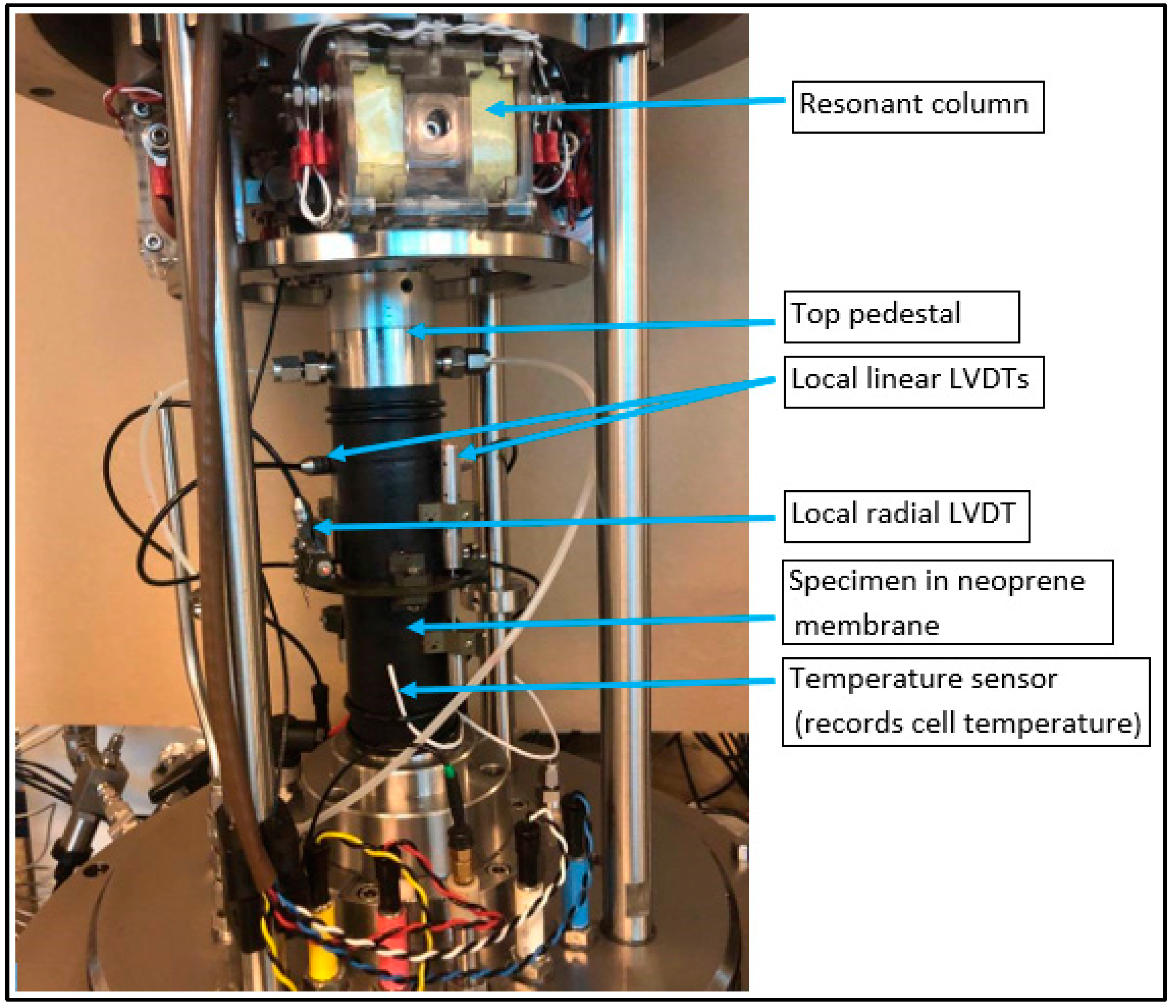

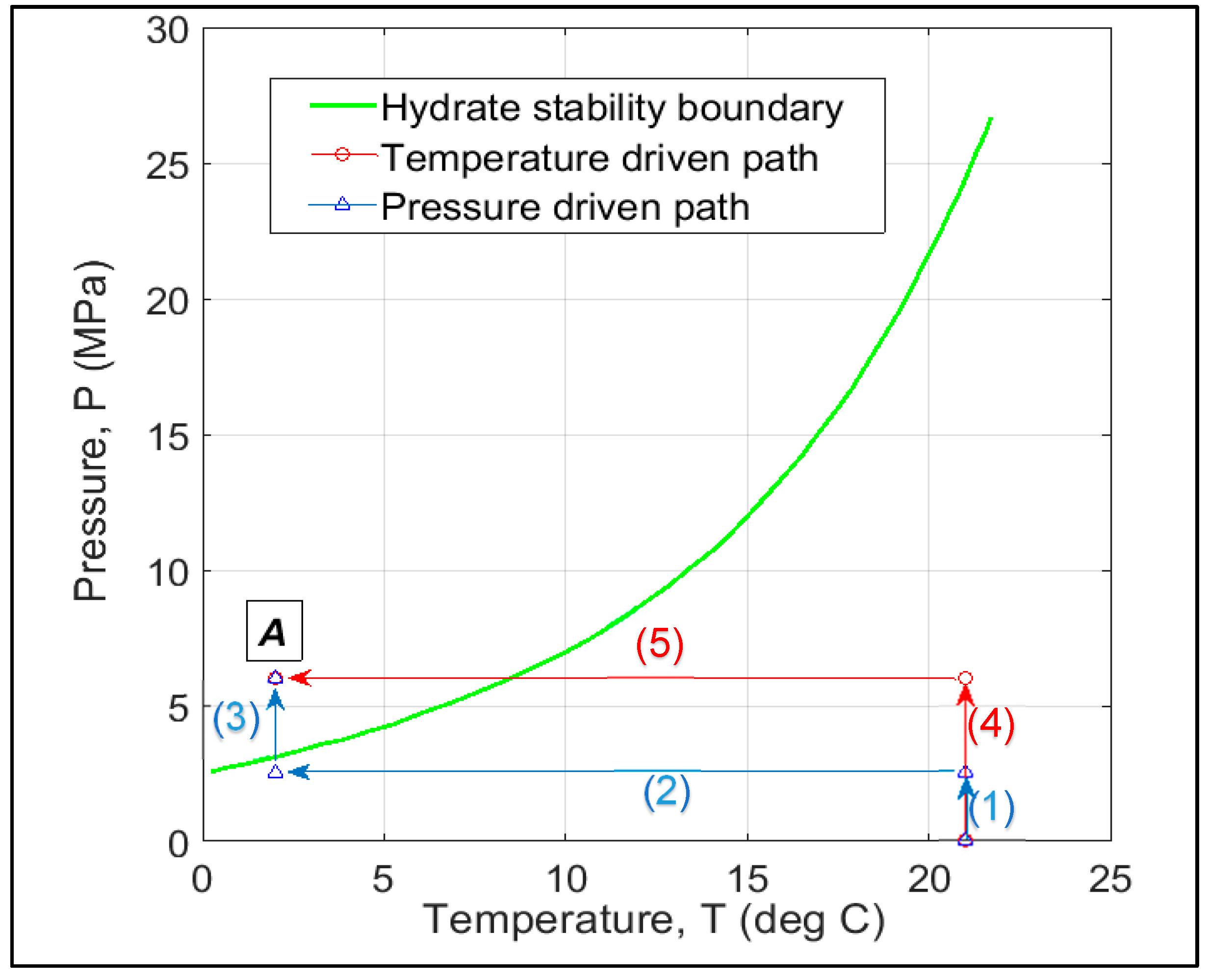

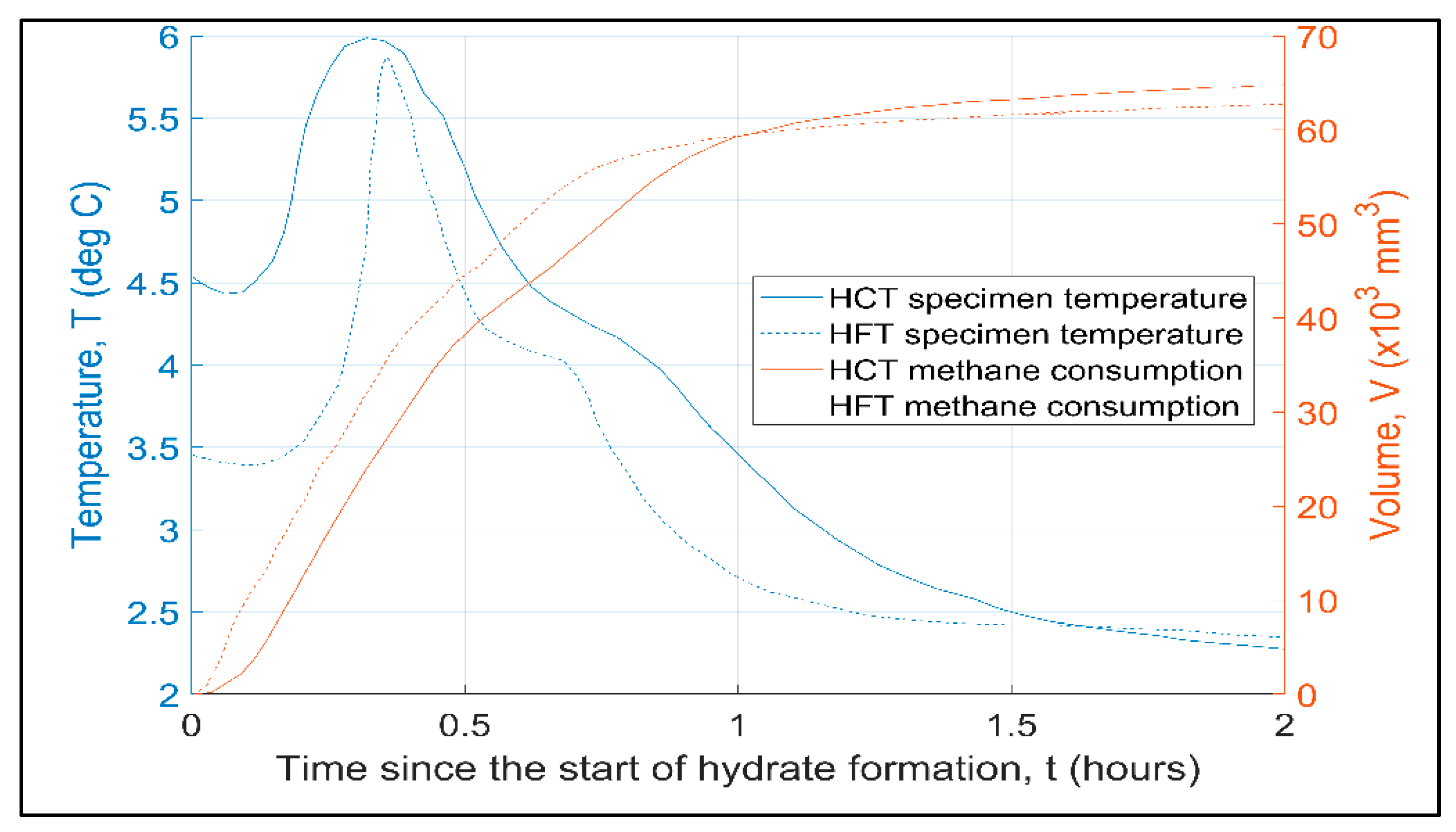
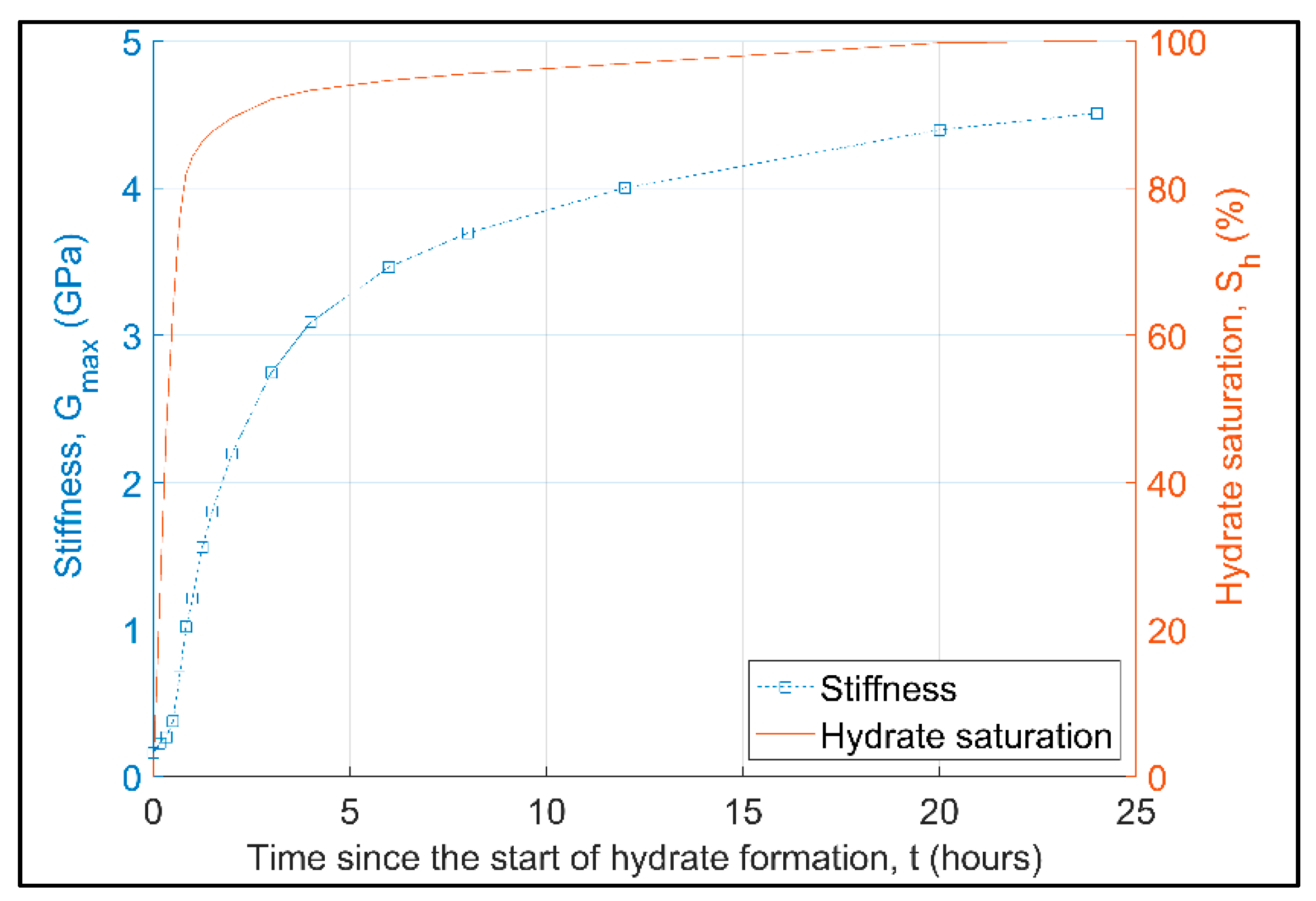
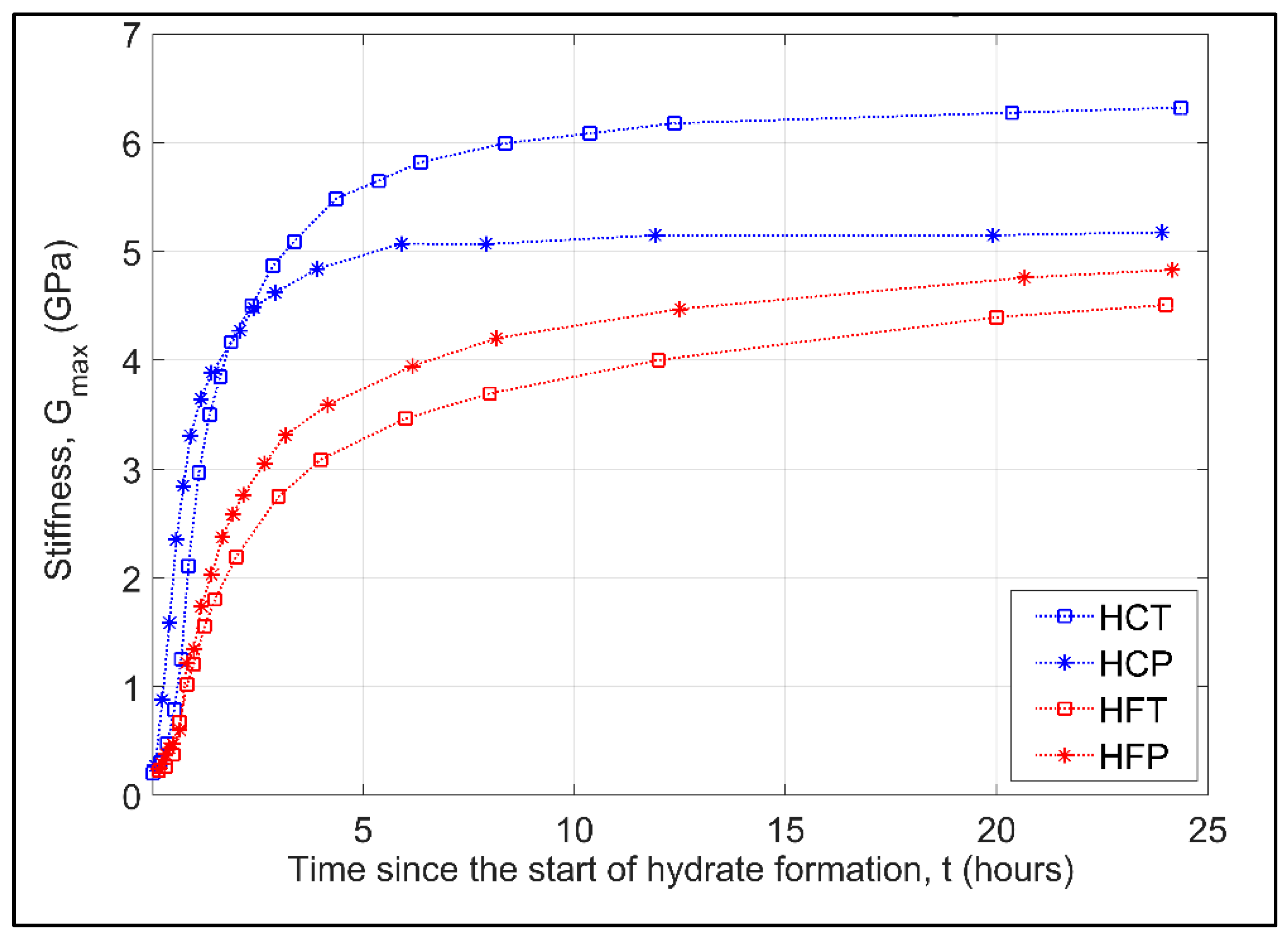

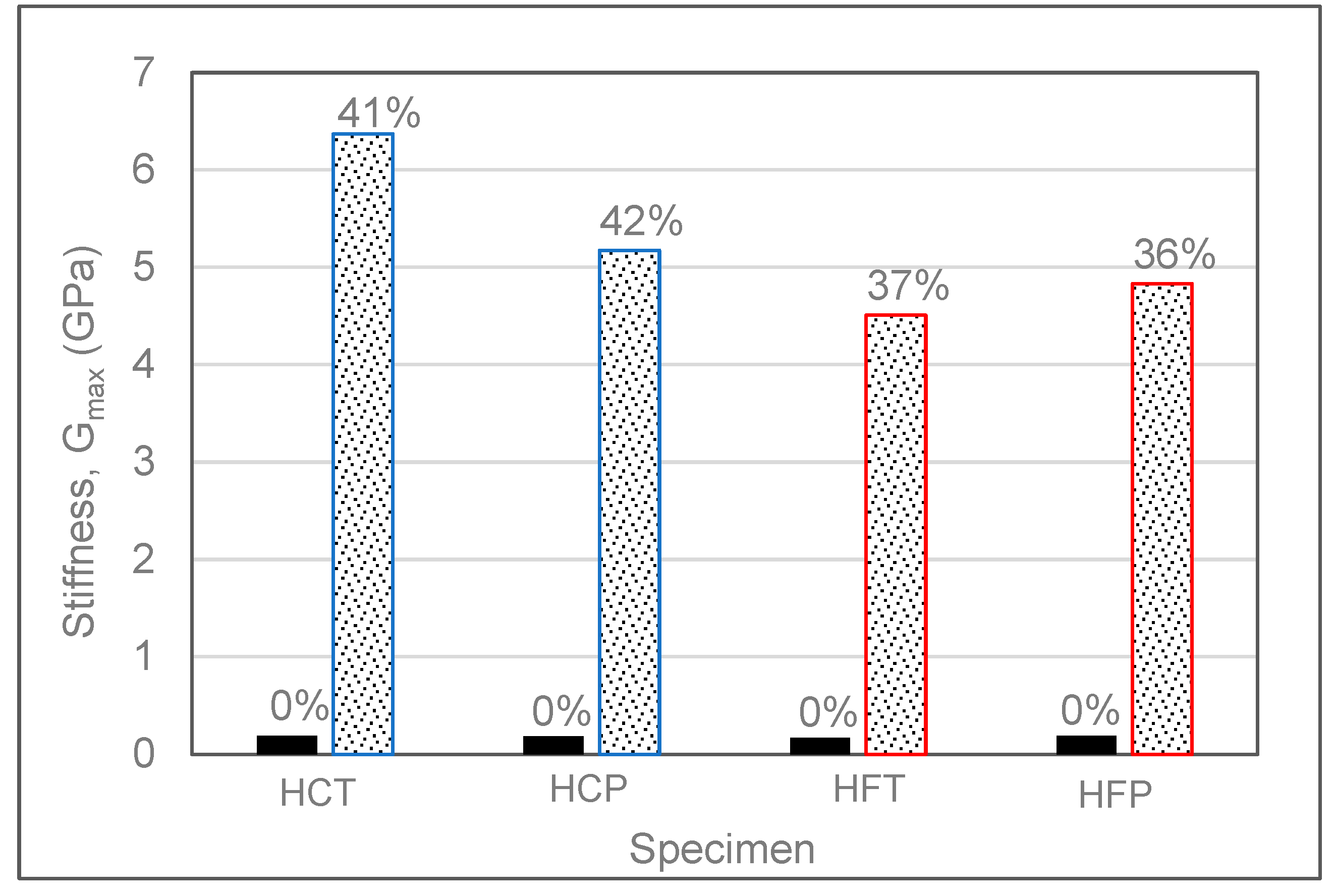
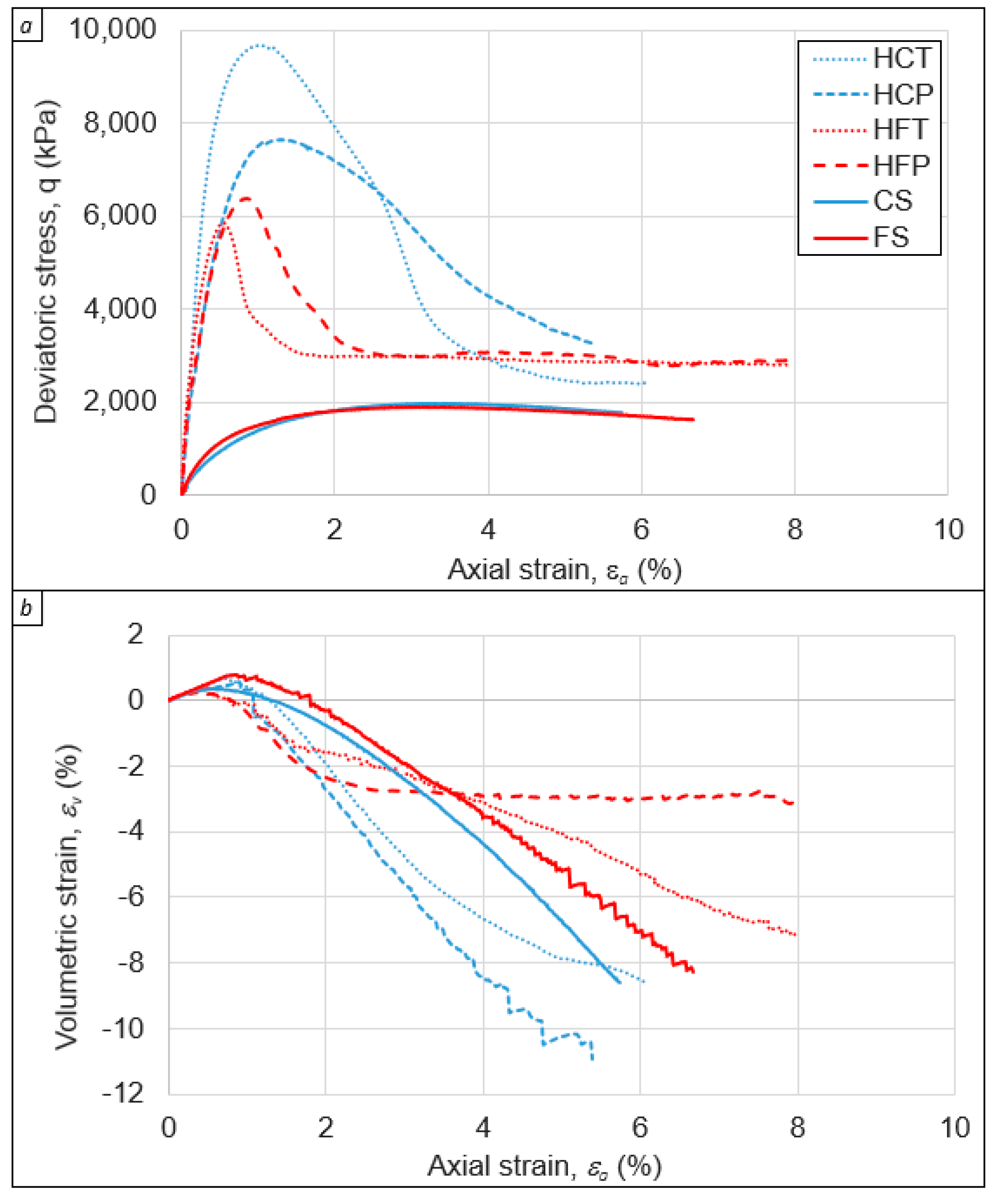
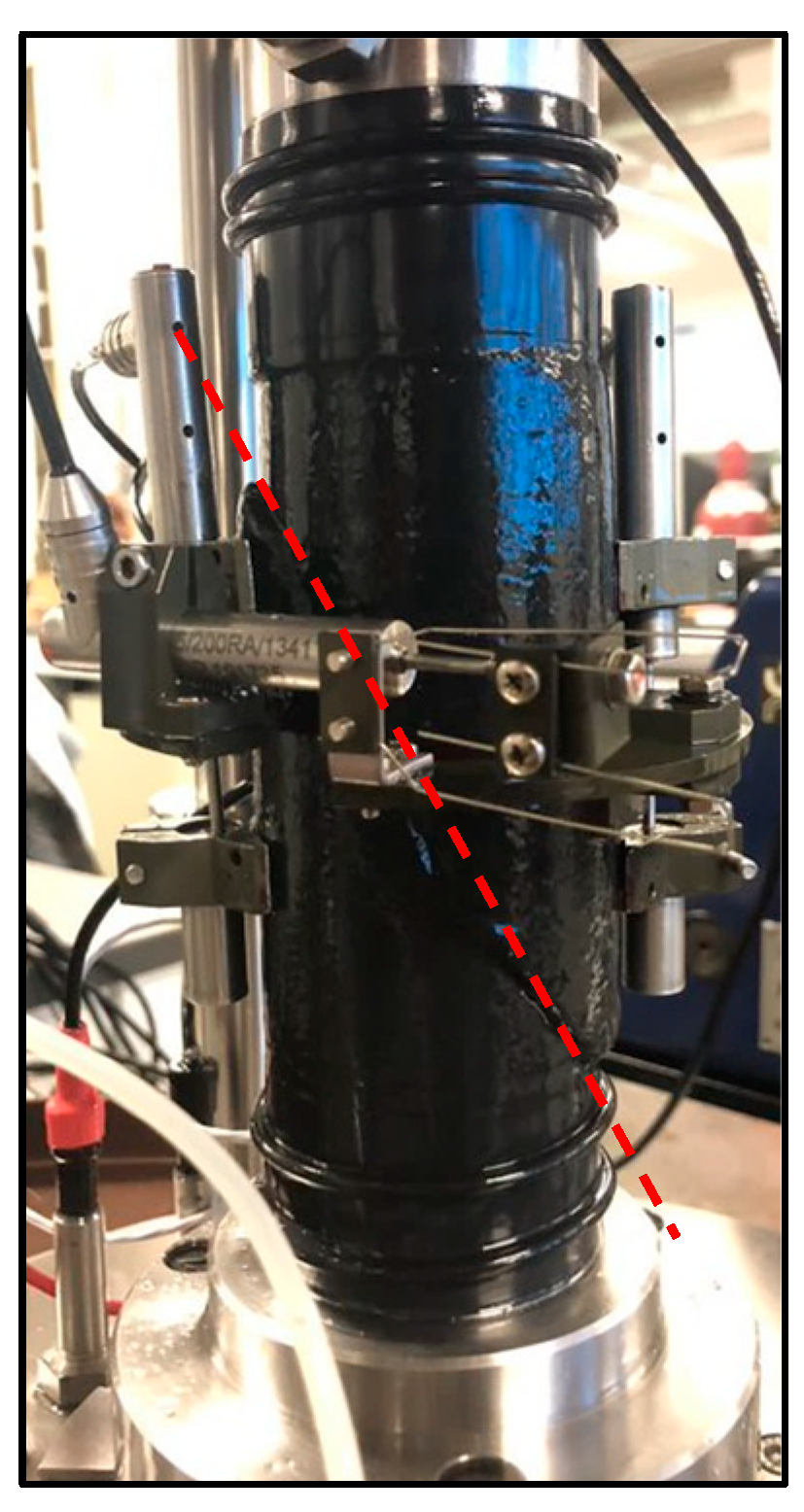
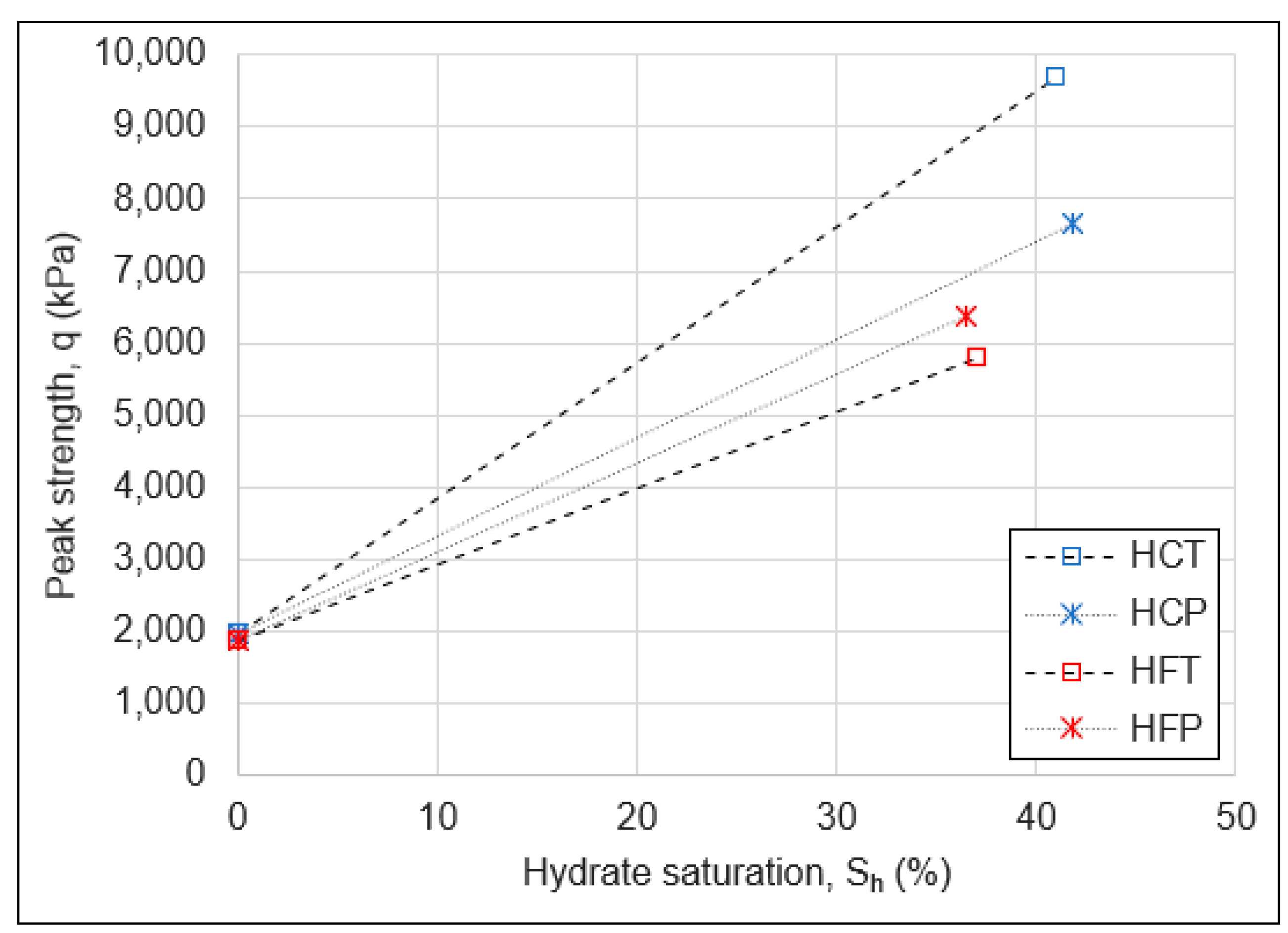
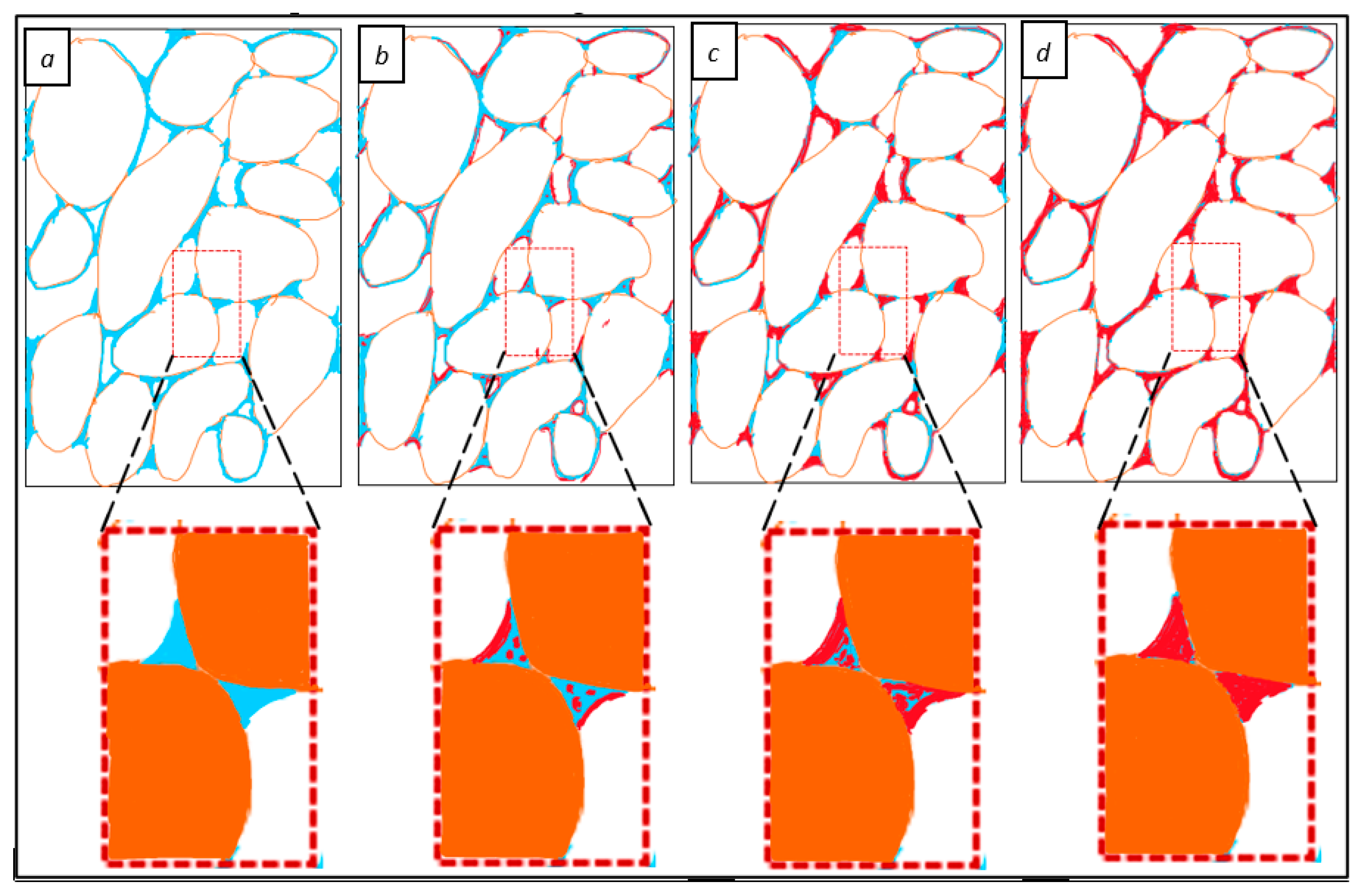
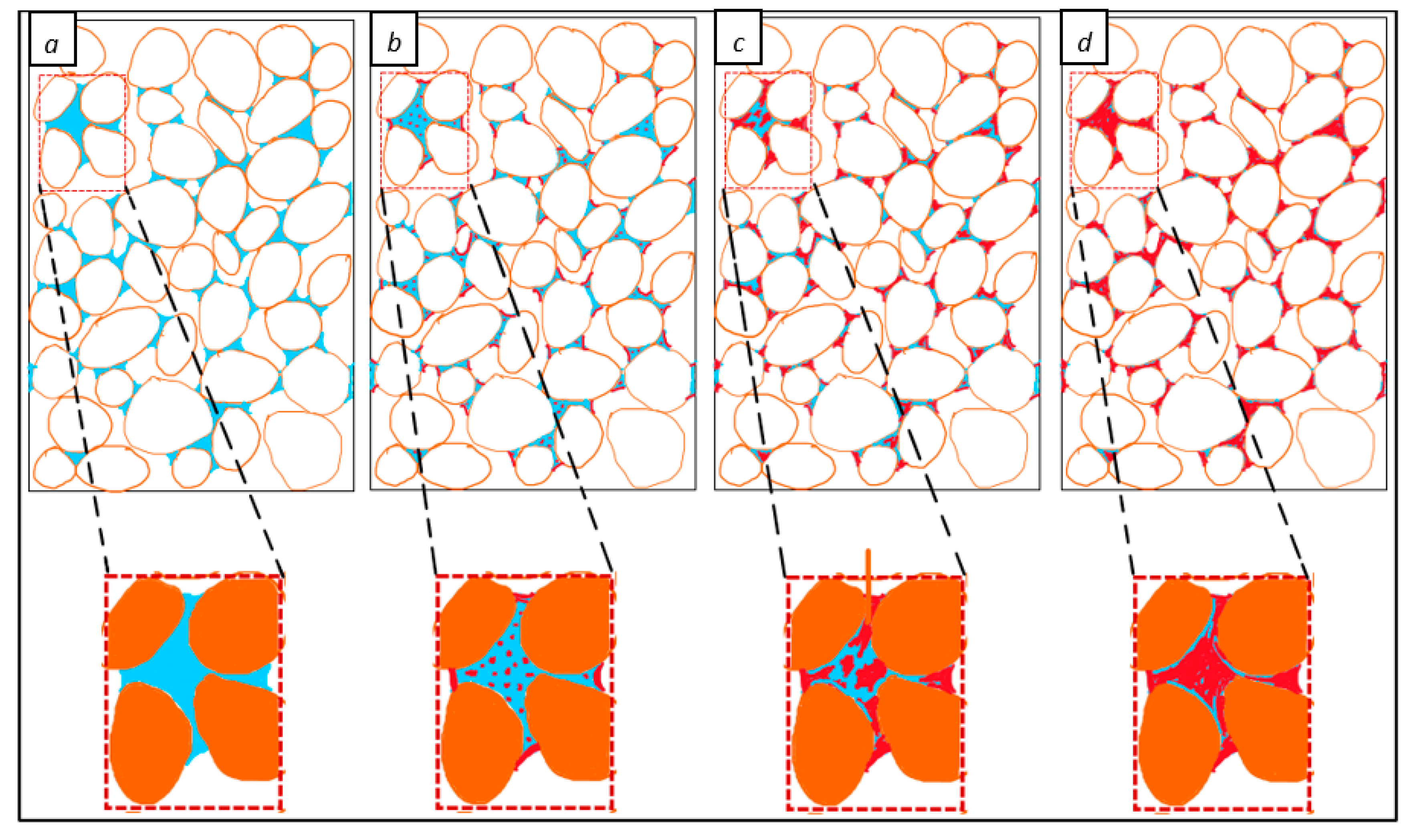
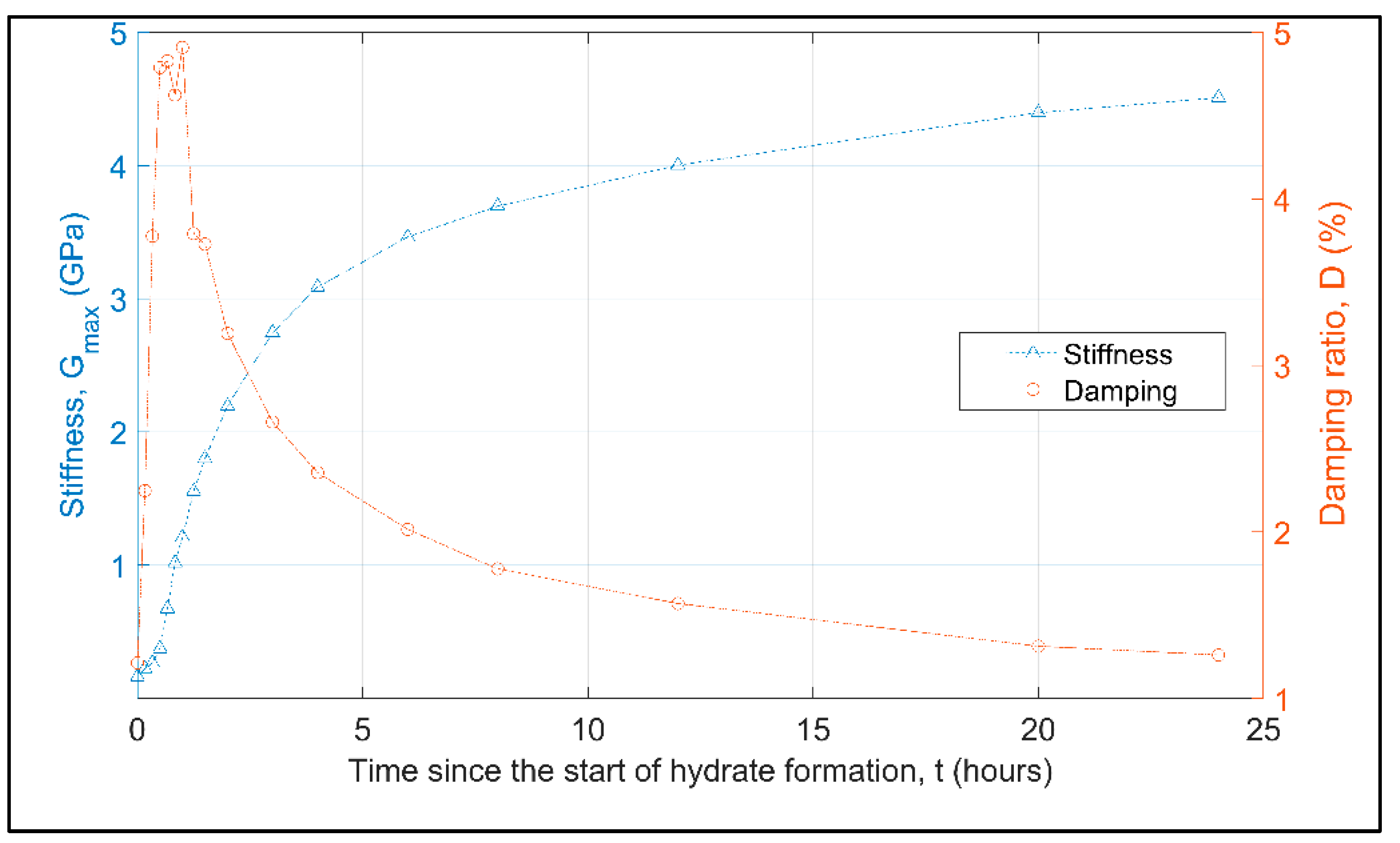
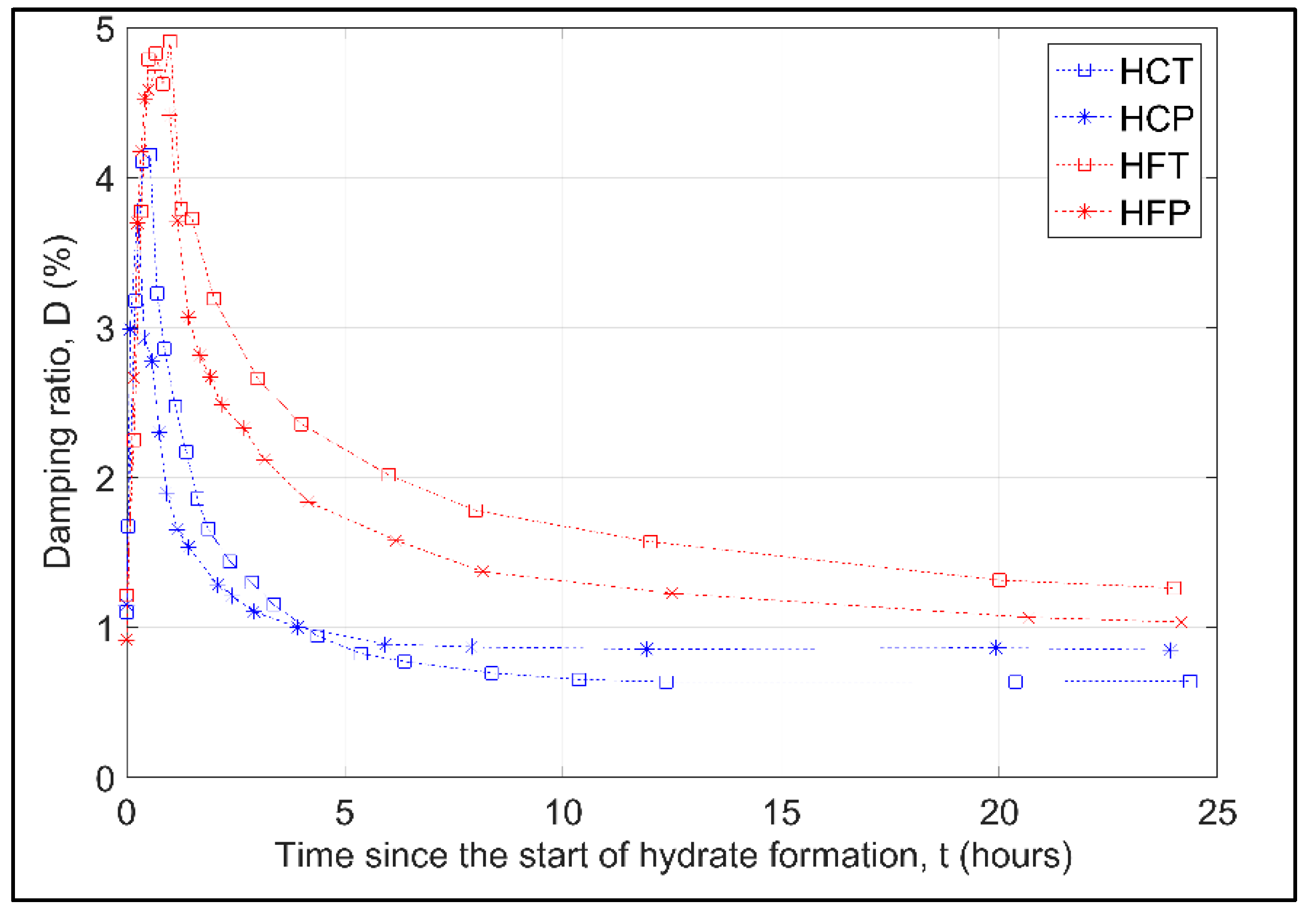
| Properties | CS (Coarser) | FS (Finer) |
|---|---|---|
| Maximum void ratio (emax) | 0.82 | 0.87 |
| Minimum void ratio (emin) | 0.44 | 0.49 |
| Mean particle diameter (D50) | 0.45 mm | 0.25 mm |
| D10 | 0.12 mm | 0.10 mm |
| D90 | 1 mm | 0.8 mm |
| Specimen * | Porosity (%) | Hydrate Formation Method | Hydrate Saturation, Sh (%) | Initial Shear Modulus, Gmax (GPa) | Final Shear Modulus, Gmax (GPa) | Peak Deviatoric Stress, qpeak (kPa) |
|---|---|---|---|---|---|---|
| CS | 33.8 | - | 0 | 0.186 | - | 1976 |
| HCT | 36.3 | Temperature driven | 41 | 0.187 | 6.323 | 9670 |
| HCP | 34.3 | Pressure driven | 42 | 0.183 | 5.176 | 7656 |
| FS | 36.3 | - | 0 | 0.205 | - | 1883 |
| HFT | 40.2 | Temperature driven | 37 | 0.170 | 4.509 | 5797 |
| HFP | 39.4 | Pressure driven | 36 | 0.189 | 4.833 | 6369 |
Publisher’s Note: MDPI stays neutral with regard to jurisdictional claims in published maps and institutional affiliations. |
© 2022 by the authors. Licensee MDPI, Basel, Switzerland. This article is an open access article distributed under the terms and conditions of the Creative Commons Attribution (CC BY) license (https://creativecommons.org/licenses/by/4.0/).
Share and Cite
Pandey, M.R.; Priest, J.A.; Hayley, J.L. The Influence of Particle Size and Hydrate Formation Path on the Geomechanical Behavior of Hydrate Bearing Sands. Energies 2022, 15, 9632. https://doi.org/10.3390/en15249632
Pandey MR, Priest JA, Hayley JL. The Influence of Particle Size and Hydrate Formation Path on the Geomechanical Behavior of Hydrate Bearing Sands. Energies. 2022; 15(24):9632. https://doi.org/10.3390/en15249632
Chicago/Turabian StylePandey, Mandeep R., Jeffrey A. Priest, and Jocelyn L. Hayley. 2022. "The Influence of Particle Size and Hydrate Formation Path on the Geomechanical Behavior of Hydrate Bearing Sands" Energies 15, no. 24: 9632. https://doi.org/10.3390/en15249632
APA StylePandey, M. R., Priest, J. A., & Hayley, J. L. (2022). The Influence of Particle Size and Hydrate Formation Path on the Geomechanical Behavior of Hydrate Bearing Sands. Energies, 15(24), 9632. https://doi.org/10.3390/en15249632










